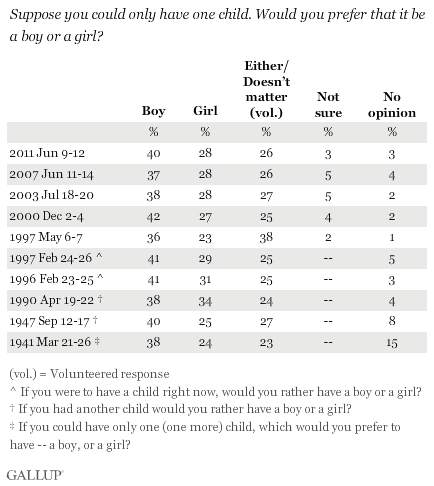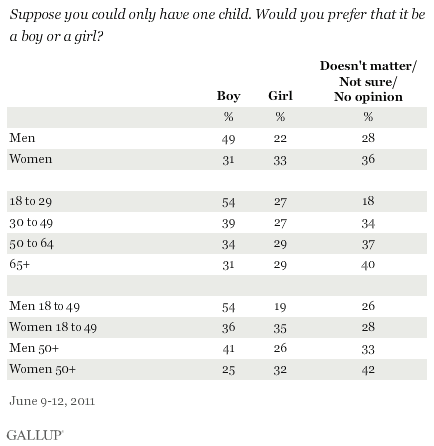PRINCETON, NJ -- If Americans could have only one child, they would prefer that it be a boy rather than a girl, by a 40% to 28% margin, with the rest having no preference or no opinion on the matter. These attitudes are remarkably similar to what Gallup measured in 1941, when Americans preferred a boy to a girl by a 38% to 24% margin.

Gallup has asked Americans about their preferences for a boy or a girl -- using slightly different question wordings over the years -- 10 times since 1941. In each instance, the results tilt toward a preference for a boy rather than a girl. The average male child-preference gap across these 10 surveys is 11 percentage points, making this year's results (a 12-point boy-preference gap) just about average. Gallup found the largest gap in 1947 and 2000 (15 points) and the smallest in a 1990 survey (4 points).
The attitudes of American men drive the overall preference for a boy; in the current poll, conducted June 9-12, men favor a boy over a girl by a 49% to 22% margin. American women do not have a proportionate preference for girls. Instead, women show essentially no preference either way: 31% say they would prefer a boy and 33% would prefer a girl.

Preference for a boy baby is inversely related to age. Americans who are younger than 30 say they would prefer a boy to a girl by a 54% to 27% margin. That boy-preference gap declines to 12 points among those 30 to 49, to 5 points among those 50 to 64, and finally to only 2 points among those 65 and older.
The highest preference for a boy by age and gender is among men under 50. Women under 50 break even in their preferences. Men 50 and older also tend to prefer a boy. Women 50 and older say they prefer a girl, by a seven-point margin.
Americans with lower education levels are more likely to say they would favor a boy; those with postgraduate education essentially break even in their preferences. There is, however, no concomitant income skew; higher-income Americans are exactly the same as the national average in their preference for a boy rather than a girl.

The preference for a boy over a girl baby is higher among Republicans than among Democrats, driven partly by the fact that American men are more likely to be Republicans and women are more likely to identify as Democrats. However, both male and female Republicans are more likely to want a boy than are their gender counterparts who identify as Democrats. In similar fashion, conservatives are significantly more likely than liberals to prefer a boy.
Implications
The real-world implications of gender-preference attitudes in some countries around the world are profound. A recent review article in the Philadelphia Inquirer pointed out that the preference for boys over girls is beginning to tilt the gender balance worldwide, a demographic shift that will have major consequences in the decades ahead. The potential impact of attitudes about the preferred gender of one's child has increased in recent years because various techniques for prenatal sex selection have become more widely available -- including ways of detecting the gender of a fetus early in the gestation process, and the increasing technological ability to select the sex of a child using in vitro and artificial insemination procedures.
The degree to which Americans deliberately attempt to select the gender of their children is unclear. It is significant that 18- to 29-year-old Americans are the most likely of any age group to express a preference for a boy because most babies are born to younger adults. The impact of the differences between men and women in preferences for the sex of their babies is also potentially important. The data from the U.S. suggest that if it were up to mothers to decide the gender of their children, there would be no tilt toward boys. Potential fathers have a clear preference for boys if given a choice, but the precise amount of input males may have into a deliberate gender-selection process is unknown.
Survey Methods
Results for this Gallup poll are based on telephone interviews conducted June 9-12, 2011, with a random sample of 1,020 adults, aged 18 and older, living in all 50 U.S. states and the District of Columbia.
For results based on the total sample of national adults, one can say with 95% confidence that the maximum margin of sampling error is ±4 percentage points.
Interviews are conducted with respondents on landline telephones and cellular phones, with interviews conducted in Spanish for respondents who are primarily Spanish-speaking. Each sample includes a minimum quota of 400 cell phone respondents and 600 landline respondents per 1,000 national adults, with additional minimum quotas among landline respondents for gender within region. Landline telephone numbers are chosen at random among listed telephone numbers. Cell phone numbers are selected using random-digit-dial methods. Landline respondents are chosen at random within each household on the basis of which member had the most recent birthday.
Samples are weighted by gender, age, race, Hispanic ethnicity, education, region, adults in the household, and phone status (cell phone only/landline only/both, cell phone mostly, and having an unlisted landline number). Demographic weighting targets are based on the March 2010 Current Population Survey figures for the aged 18 and older non-institutionalized population living in U.S. telephone households. All reported margins of sampling error include the computed design effects for weighting and sample design.
In addition to sampling error, question wording and practical difficulties in conducting surveys can introduce error or bias into the findings of public opinion polls.
View methodology, full question results, and trend data.
For more details on Gallup's polling methodology, visit www.gallup.com.
